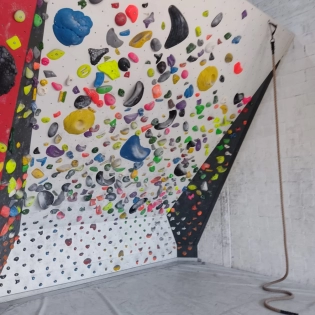
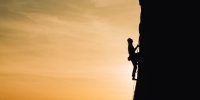

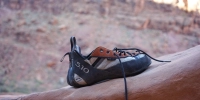
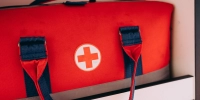

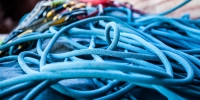
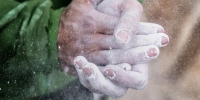
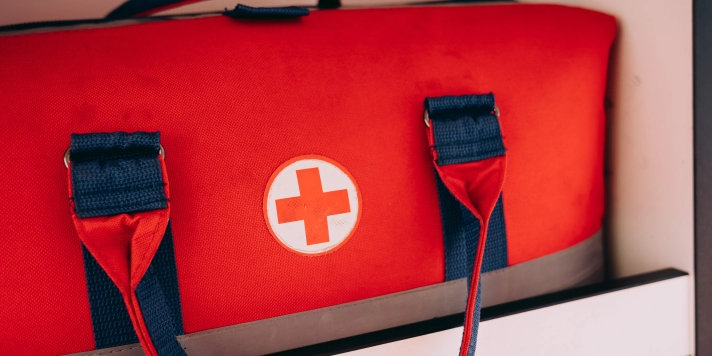
health, injuries, & safety
For me, after climbing for about a year, I noticed that my toes are more squished together, especially the tips of my toes. They have a sharper square shape rather than a round shape.
I put a vitamin E cream on my hands before I fall asleep. I feel it really helps after sessions that leave me with pulsating red fingertips with little to no skin. The one I use is from Jason, its a 25,000 IU cream, but there are also oils with 75,000 IU, I haven't tried that yet though.
Leaving the cream on overnight does help quite noticeably. It doesn't completely heal the skin after one night, but usually after a second night of doing this I can climb again the next day.

To help prevent finger injuries from recurring in rock climbing, here are a few tips:
- Warm-up: Always warm up your fingers and hands before climbing. Engage in light stretching exercises and gradually increase the intensity to prepare your tendons and muscles for the demands of climbing.
- Proper Technique: Focus on using proper climbing technique and body positioning. This includes using your lower body and core strength effectively, which can reduce excessive strain on your fingers.
- Gradual Progression: Avoid overexertion and progressing too quickly. Gradually increase the intensity and difficulty of your climbs to allow your fingers and tendons to adapt and strengthen over time.
- Finger Strength Training: Incorporate finger strength training exercises into your routine. This can include using fingerboards, hangboards, or grip strengtheners to improve finger strength and resilience.
- Rest and Recovery: Allow for proper rest and recovery between climbing sessions. Adequate rest helps your body repair and strengthen, reducing the risk of overuse injuries.
- Listen to Your Body: Pay attention to any signs of discomfort, pain, or fatigue in your fingers. If you experience any issues, it's important to address them promptly and seek appropriate rest and treatment as needed.
- Finger Care: Take care of your fingers by keeping the skin moisturized, avoiding excessive filing of calluses, and addressing any minor injuries or cuts promptly to prevent infections.
- Proper Gear: Ensure that you are using properly fitted climbing shoes and equipment that provide support and minimize stress on your fingers.
Remember, while these tips can help reduce the risk of finger injuries, it's important to listen to your body and consult with a healthcare professional or qualified trainer for personalized advice based on your specific needs and circumstances.
To help facilitate the healing process of a finger pulley injury, here are a few suggestions:
- Rest: Give your injured finger time to rest and avoid any activities that may aggravate the injury. Minimizing strain and allowing adequate recovery time is crucial.
- Ice: Applying ice to the injured area can help reduce swelling and inflammation. Use an ice pack or wrap ice in a thin cloth and apply it to the injured finger for about 15-20 minutes at a time, several times a day.
- Compression: Consider using compression bandages or finger sleeves to provide support and help reduce swelling. Be sure not to wrap too tightly, as it may hinder blood flow.
- Elevation: Elevating your hand and keeping it above heart level can assist in reducing swelling and promoting healing.
- Gentle Range of Motion Exercises: Once the acute phase of the injury has passed, gentle range of motion exercises, as recommended by a healthcare professional, can help maintain finger mobility and prevent stiffness.
- Gradual Rehabilitation: As your finger improves, gradually introduce strengthening exercises and gradually increase the intensity of your climbing or finger-specific training. However, it's important to consult with a healthcare professional or a qualified hand therapist before starting any rehabilitation exercises.
Remember, everyone's healing process may vary, and it's essential to listen to your body and seek guidance from a medical professional to ensure proper care and recovery.
Rock climbing can put strain on your feet, but whether it causes damage depends on various factors. The repetitive pressure and friction can lead to calluses, blisters, and even corns. However, these issues are typically temporary and can be managed with proper foot care and footwear. The use of climbing shoes, which provide a snug fit and a specialized rubber sole, can help improve grip and protect your feet. It's important to listen to your body and take breaks if you experience discomfort or pain.
Climber's elbow, also known as medial epicondylitis or golfer's elbow, is a common overuse injury among climbers. It refers to the inflammation or irritation of the tendons on the inner side of the elbow, near the bony bump called the medial epicondyle. It can result from repetitive stress or strain on the muscles and tendons that control wrist and finger flexion. Symptoms of climber's elbow may include pain and tenderness on the inner side of the elbow, weakness in grip strength, and difficulty in fully bending or straightening the arm. Rest, ice, stretching, and strengthening exercises are typically recommended for recovery, but it's always a good idea to consult with a healthcare professional for a proper diagnosis and treatment plan.
Rock climbing is considered a high-risk sport due to its inherent nature and the potential dangers involved. The sport involves ascending steep rock faces or cliffs using a variety of techniques and equipment. While safety measures and equipment have greatly improved over the years, there are still inherent risks that climbers must be aware of and mitigate to ensure their safety. Here are some reasons why rock climbing is considered high risk:
-
Falls: Falling is one of the primary risks in rock climbing. Even with the use of safety equipment such as harnesses, ropes, and protective gear, a fall can still result in injury or even death, depending on the height and terrain involved.
-
Equipment failure: Climbing equipment, including ropes, carabiners, and harnesses, must be in good condition and used correctly to ensure safety. Equipment failure or improper usage can lead to accidents and injuries.
-
Environmental hazards: Climbing takes place in various outdoor environments, and climbers are exposed to natural elements such as weather changes, loose rocks, falling debris, and wildlife. These factors can add to the risks involved.
-
Physical demands: Rock climbing requires a high level of physical fitness, strength, and technique. Fatigue, muscle strain, and overexertion can increase the risk of accidents and injuries.
-
Lack of control: Unlike some other sports where the environment is controlled, rock climbing takes place in unpredictable and ever-changing natural settings. Factors such as rock quality, weather conditions, and route difficulty can affect the level of risk.
Pulley and skin damage are probably the most common finger injuries or finger damage for climbers.
They can both normally be prevented, though, if the climber is first of all aware of these two risks and knows how to minimize them, which largely means paying attention and listening to your body.
Rock climbing is a very arm-heavy sport, as it mostly utilizes muscles responsible for pulling and holding. The muscles most used for these are your back muscles and your arms. Just like with lifting weights, these muscles can tear and get damaged, which causes the pain you may feel, but it's also what causes them to grow and get stronger.
Rock climbing requires you to pull much of your body weight, and to keep you on the wall and close to it. This means that your muscles, especially your arm muscles, with be very heavily used for this, and in ways that you may not be used to, especially if you are a beginner rock climber.
Your shoulders, all the way down to your forearms, are used to help you move from hold to hold, and to help you grip the holds and stabilize yourself on the wall. This means that you will be pulling much of your body weight on with your arms, and you will most likely be doing it in ways that will cause your muscles to go through the same process they would go through when lifting weights. They will get damaged, which is what will cause them to hurt, and it is also what will cause them to grow and get stronger. Eventually, as you progress with your climbing, they will hurt less.



